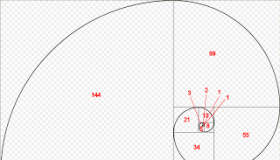
For sure someone remember the Fibonacci Sequence coming from math studies during High School or at Universitiy.
It is a sequence of Natural numbers, designed from mathematicians in India and described in Europe at beginning of the 13th century by Filippo Bonacci:
1 1 2 3 5 8 13 21 34 55 89 144 ...
It is simple to build up, just making the n-th number the sum of (n-1)th and (n-2)th. That is, 21 = 13 + 8: 8th = 7th + 6th; and also, 144 = 89 + 55: 12th = 11th + 10th.
But it is not only a math joke. There is a deep meaning:
the lim n-> infinitive of the ratio (n+1)th/(n)th brings to the Golden-Ratio (i.e. 1.61803398...)
That is:
- having n sufficiently huge, the ratio (n+1)th/n-th is a good round of Golden-Ratio
- it is possible to figure out Golden Ratio only by the mean of natural numbers (not figthing against real number, floating point ones)
- each life-being mind (i.e. belonging to a man, a animal, a fish, a tree) can conceive the Golden Ratio, by the means of Fibonacci and Natural numbers
There are a lot of examples of life-being (especially trees and vegetals) adapting Golden Ratio to itself (i.e. number of petal in flowers, branches in trunks, etc) through subsequent (n, n+1) Fibonacci numbers.
Fibonacci brings to effective solutions that make things working for life-being, in general.
Ok. So, what for real life?
The answer comes from ancestors, more precisely from ancient Greece and Roman Empire.
Greeks learns us that the only way for having beauty is employing Golden-Ratio (e.g. ratio between height and width of Parthenon, in the Acropolis of Athens). That is, Beauty <=> Golden-Ratio
Romans built their huge Empire by focusing beauty for building useful things, valuable for consolidating the infrastructure and improving the supremacy. That is, in order to enhance one of the most valuable empire, Usefulness => Beauty. And also, Benefit => Beauty. So, NO Beauty => NO Benefit
Putting all together:
- In designing useful solutions, use subsequent Fibonacci numbers for individuating the elements that should interact each other. Each element should be build using Fibonacci number, in turn
- In reviewing goodness of solutions, identify all proper Golden-Ratio (or approximate value) between elements
- In evaluating effective benefits of solution, analyze the number of identified Golden-Ratio relationships, by comparing it to 5 solution attributes, using proper 5 KPIs. For instance, the following could be used:
- Elements: ratio between the number elements and Golden-Ratios
- Interactions: ratio between the number of interaction betwen elements and Golden-Ratios
- Types: ratio between the number of element types and the Golden-Ratios
- Intensity: ratio beteen the number of different forces make the solution running and the Golden-Ratios
- Complexity: ratio between the number of different powers that apply to the solution and the Golden-Ratios
If Fibonacci works very good in nature for life-beings, it should be the same for real-life. Romans explained us issuing their 1000+ years Empire.
